The Paintings of James McNeill Whistler
YMSM 075
The Morning after the Revolution, Valparaiso
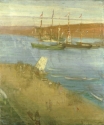
Date
The Morning after the Revolution, Valparaiso dates from 1866, or at least was started in 1866.

The Morning after the Revolution, Valparaiso, 1866, The Hunterian
Whistler spent six months in Chile in 1866 at the time of a brief confrontation between Chile and Spain. 1 According to Whistler's diary for the trip to South America, he left Southampton on 2 February 1866 and arrived in Valparaiso on 12 March, where he remained, except for occasional visits to Santiago and the surrounding countryside, until sailing for England early in September 1866. 2
Whistler's account of this trip and bombardment, as told to his biographers, the Pennells, is as follows:
'It was a moment when many of the adventurers the war had made of many Southerners, were knocking about London, hunting for something to do, and, I hardly knew how, but the something resolved itself into an expedition to go and help the Chilians and, I cannot say why, the Peruvians too. Anyhow, there were South Americans to be helped against the Spaniards. Some of these people came to me, as a West Point man, and asked me to join and it was all done in an afternoon. I was off at once in a steamer from Southampton to Panama. We crossed the Isthmus, and it was all very awful earthquakes and things and I vowed, once I got home, that nothing would ever bring me back again.
I found myself in Valparaiso, and in Santiago, and I called on the President, or whoever the person then in authority was. After that came the bombardment. There was the beautiful bay with its curving shores, the town of Valparaiso on one side, on the other, the long line of hills. And there, just at the entrance of the bay, was the Spanish fleet, and, in between, the English fleet, and the French fleet, and the American fleet, and the Russian fleet, and all the other fleets. And when the morning came, with great circles and sweeps, one after another sailed out into the open sea, until the Spanish fleet alone remained. It drew up right in front of the town, and bang went a shell, and the bombardment began. The Chilians didn't pretend to defend themselves. The people all got out of the way, and I and the officials rode to the opposite hills, where we could look on. The Spaniards conducted the performance in the most gentlemanly fashion ; they just set fire to a few of the houses, and once, with some sense of fun, sent a shell whizzing over toward our hills. And then I knew what a panic was. I and the officials turned and rode as hard as we could, anyhow, anywhere. The riding was splendid, and I, as a West Point man, was head of the procession. By noon, the performance was over. The Spanish fleet sailed again into position, the other fleets sailed in, sailors landed to help put out the fires, and I and the officials rode back into Valparaiso.' 3
This account may have been embellished, but basically shows that Whistler did return to the city immediately after the brief bombardment, and so could have painted the harbour shortly afterwards. The title of the painting is very specific, namely 'The Morning after the Revolution'. Sutherland suggests: 'Whistler may have set up his easel as early as April 1, the day after the bombardment.' 4
The painting was folded up and damaged at some time, possibly on its way back from Chile, and later repaired and possibly reworked by Whistler.
Images

The Morning after the Revolution, Valparaiso, 1866, The Hunterian
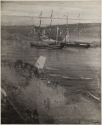
The Morning after the Revolution, Valparaiso, photograph, 1960s
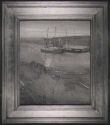
The Morning after the Revolution, Valparaiso, frame
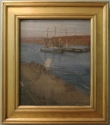
The Morning after the Revolution, Valparaiso, frame
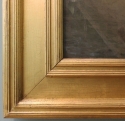
The Morning after the Revolution, Valparaiso, frame detail

Sketch for 'Nocturne in Blue and Gold: Valparaiso Bay, Smithsonian American Art Museum

Nocturne in Blue and Gold: Valparaiso Bay, Freer Gallery of Art
Subject
Titles
Whistler's original title is not known, although he may have given it the current site and time specific title:
- 'The Morning after the Revolution – Valparaiso' (1936, University of Glasgow). 5 ?
- 'The Morning after the Revolution, Valparaiso' (1980, YMSM). 6
'The Morning after the Revolution, Valparaiso' is the definitive title.
Description

The Morning after the Revolution, Valparaiso, 1866, The Hunterian
A vertical composition, showing the view from an upper window down onto a pier and across a bay to distant hills. The pier crosses the lower left corner diagonally. There are groups of people on the pier and a small sailing boat moored by the pier, and several small rowboats moored in the bay to the right of the pier. In the bay are at least six two- and three-masted sailing ships, sails furled, and flags fluttering. The sky is a pale greenish blue with a streak of lilac cloud, the sea a slightly darker blue, the hills beyond the bay are brown and the pier a pale ochre. The sails and rowboats are white, and the white flags are touched with red and blue.
Site
The port of Valparaiso, Chile. Whistler's paintings, according to Sutherland, 'are among the few visual records of the Spanish blockade, apparently the only eyewitness views.' 7
Technique
Composition

The Morning after the Revolution, Valparaiso, 1866, The Hunterian

Sketch for 'Nocturne in Blue and Gold: Valparaiso Bay, Smithsonian American Art Museum
The Morning after the Revolution, Valparaiso is closely related to Sketch for 'Nocturne in Blue and Gold: Valparaiso Bay' y074, which has a similar lighting effect. The Morning after the Revolution, Valparaiso, however, has two additional ships in the background, and small boats by the pier.

Nocturne in Blue and Gold: Valparaiso Bay , Freer Gallery of Art
The final version of the subject appears to be Nocturne in Blue and Gold: Valparaiso Bay y076, which is, as the title suggests, a night scene, and includes even more ships and figures, but no sailing boat by the pier or small boats in the bay.
The high viewpoint could be considered an early example of the influence of Japanese woodcuts on the composition, but is actually more likely to be the result of Whistler literally painting from a high viewpoint.
Technique
The canvas is a fairly fine tightly woven fabric, lined with a similar material. The structure is confusing, with a lumpy surface that may be the result of a layer of priming used to partly cover an earlier painting, or earlier version of the same subject. The final painting is thinly painted over this lumpy surface. 8

The Morning after the Revolution, Valparaiso, 1866, The Hunterian
The priming is conventional: a layer of lead white and chalk in oil, applied over a more chalk-rich layer. There is a very thin, artist-applied pink/mushroom imprimatura made from natural red ochre and bone black. Lead white, bone black, vermilion, yellow ochre, brown ochre, madder, cobalt blue, and natural ultramarine were used. 9
There are extensive signs of alterations in The Morning after the Revolution, Valparaiso. There was some damage and repainting in the upper left corner and on parts of the pier. The central ship was originally heeling more to the left, with both masts further left. The ship at upper right has been almost eliminated, the sea being painted over it. Under-drawing was used for the hulls of the large masted ships. There appear to have been changes in the number and grouping of figures on the pier. The pier was originally slimmer on both sides, and it was drawn in some detail, as were most of the figures on it. Its left side was painted over water, but is not fully resolved.
In 1874 Whistler apparently considered at least one of his Valparaiso paintings unfinished, mentioning the possible sale of 'the Valparaiso piece if I ever finish it'. 10 This could refer to The Morning after the Revolution, Valparaiso but it is more likely to refer to Nocturne in Blue and Gold: Valparaiso Bay y076, which also shows signs of extensive reworking.
The Morning after the Revolution, Valparaiso is a bright, bold, and vivid painting, a bridge between the realism of earlier sea- and river-scapes, such as Grey and Silver: Chelsea Wharf y054 and Crepuscule in Opal: Trouville y067, and later nocturnes, particularly Nocturne in Blue and Gold: Valparaiso Bay y076.
Conservation History
There is extensive evidence of damage down the centre of the canvas, arising from old creases, folds or even tears, which have been repaired and secured by lining the canvas at some time. The lining is an unusual bleached linen.
Although the painting is structurally sound, there are signs of damage, paint loss, and uneven paint staining, which may be the result of the under-layer of paint and priming, and there are some areas of surface cracking and bubbling. 11 It has had a hard life!
Frame

The Morning after the Revolution, Valparaiso, frame

The Morning after the Revolution, Valparaiso, frame

The Morning after the Revolution, Valparaiso, frame detail
Flat Whistler frame, which could date from the late 1860s or 1870s. However, since the painting was never exhibited, it may have been a frame that was in Whistler's studio, and not actually intended for this painting. 108.5 x 95.1 x 4.0 cm.
History
Provenance
- 1879: at the time of Whistler's bankruptcy, possibly deposited for safe keeping with William Cleverly Alexander (1840-1916);
- 1903: returned by Alexander to Whistler's ward and executrix, Rosalind Birnie Philip (1873-1958);
- 1935: given by Miss R. Birnie Philip to the University of Glasgow.
Whistler's biographers, the Pennells, report:
'He made good use of his time in Valparaiso, and painted the three pictures of the harbour which are known and two others which have disappeared. These he gave to the steward, or the purser of the ship, to bring home, and the purser kept them. Once they were seen in his rooms, or house, in London by some one who recognised Whistler's work. "Why, they must be by Whistler!" he said. "Who's Whistler?" asked the purser. "An artist," said the other. "Oh, no," said the purser, "they were painted by a gentleman." The purser started back for South America, and took them with him. "And then a tidal wave met the ship and swept off the purser, the cabin and the Whistlers." ' 12
Whistler was involved in commissions for the London banker W. C. Alexander from 1870 onwards, and it is possible that he left The Morning after the Revolution, Valparaiso with Alexander during that time, although it is more likely that it was left there at the time of Whistler's bankruptcy in 1879 to avoid the necessity of selling or destroying it. It could even have been left with Alexander at a later date, since they remained on good terms through the 1890s.
Paintings or a painting called 'Valparaiso' were sold at auction in Christie's, London, on 24 July 1878 (lot 78) and 30 June 1883 (lot 252) and bought in by Furber & Price, and Allingham, respectively. It is most likely that these paintings were Crepuscule in Flesh Colour and Green: Valparaiso y073, and Symphony in Grey and Green: The Ocean y072, respectively, although it is just possible that one or both sales refer to The Morning after the Revolution, Valparaiso.
In a list Whistler made of his pictures in 1886 or 1887 only three Valparaiso pictures were recorded, 'Valparaiso - Twilight -Valparaiso - grey rain ... Nocturne Blue & Silver. Old Hill - Valparaiso.' 13 These are identified as Symphony in Grey and Green: The Ocean y072, Crepuscule in Flesh Colour and Green: Valparaiso y073, and Nocturne in Blue and Gold: Valparaiso Bay y076. However, neither The Morning after the Revolution, Valparaiso nor Sketch for 'Nocturne in Blue and Gold: Valparaiso Bay' y074 are mentioned, possibly because he did not think them exhibitable.
In 1903 Charles Lang Freer (1856-1919) visited W. C. Alexander in London and saw a 'Sketch of the Valparaiso shown at Chicago', which had been 'left by Mr Whistler and never sent for.' 14 Freer reported this to Whistler's ward and executrix, Rosalind Birnie Philip (1873-1958) and she asked Alexander to return it, which he did.
Exhibitions
It was not exhibited in Whistler's lifetime.
By the terms of the gift made by Rosalind Birnie Philip (1873-1958), to the University of Glasgow in 1935, it is not lendable.
Bibliography
Catalogues Raisonnés
- Young, Andrew McLaren, Margaret F. MacDonald, Robin Spencer, and Hamish Miles, The Paintings of James McNeill Whistler, New Haven and London, 1980 (cat. no. 75), plate 58, as 'The Morning after the Revolution, Valparaiso'.
Authored by Whistler
- None.
Catalogues 1855-1905
SALE:
- Possibly Christie's, London, 24 July 1878 (lot 78) as 'Valparaiso'.
- Possibly Christie's, London, 30 June 1883 (lot 252) as 'Valparaiso'.
Journals 1855-1905
- None.
Monographs
- None.
Books on Whistler
- Anderson, Ronald, and Ann Koval, James McNeill Whistler: Beyond the Myth, London, 1994, pp. 159-60.
- Spencer, Robin, Whistler, New York, 1990, p. 35.
- Sutherland, Daniel E., Whistler: A Life for Art's Sake, New Haven and London, 2014, pp. 95-98.
Books, General
- Fattal, Laura Rachel Felleman and Carol Salus (eds), Out of Context: American Artists Abroad, in series Contributions to the study of art and architecture, Westport, CT, 2004, p. 14-15.
- Jacobs, Michael, The Painted Voyage: Art,Travel and Exploration 1564-1875, London, 1995, pp. 145, 147 repr.
- Kloss, William, Treasures of NMAA, Smithsonian, Washington DC, 1986, p. 68.
- Manthorne, Katherine E., Tropical Renaissance: North American Artists Exploring Latin America, 1839-1879, Smithsonian Institution Press, Washington, DC, 1989, pp. 159, 165-67, 169, 171, repr. fig. 93.
- Sutherland, Daniel E., Whistler: A Life for Art's Sake, New Haven and London, 2014, p. 97.
Catalogues 1906-Present
COLLECTION:
- Hopkinson, Martin J., James McNeill Whistler at the Hunterian Art Gallery, University of Glasgow, Glasgow, 1990, pp. 16-17, repr.
- Hopkinson, Martin J., in Lawrence Keppie (ed.), Souvenir Guide, Hunterian Museum and Art Gallery, University of Glasgow, Glasgow, 1990, repr. fig 6.
EXHIBITION:
- James McNeill Whistler, University of Glasgow, Glasgow, 1936 (cat. no. 29).
- Kloss, William, Treasures from the National Museum of American Art, Washington and London, 1985 (ref. cat. no. 27) (not exhibited).
- Lochnan, Katharine A., Whistler and his Circle: Etchings and Lithographs from the collection of the Art Gallery of Ontario, Kitchener/Waterloo Art Gallery, Kitchener, Ontario, 1987, p. 41 (not exhibited).
- Sutton, Denys, 'Whistler: The Artist as Dandy', in: ホイスラー展. Whistler Exhibition in Japan, Isetan Museum of Art, Tokyo; Hokkaido Museum of Modern Art, Sapporo; Shizuoka Prefectural Museum, Shizuoka, 1986, pp. 22-30, at p. 23 (not exhibited).
- Dorment, Richard, and Margaret F. MacDonald, James McNeill Whistler, Tate Gallery, London, Musée d’Orsay, Paris, and National Gallery of Art, Washington, DC, 1994-1995, pp. 110, 119, 175, 312 (not exhibited).
Journals 1906-Present
- Getscher, Robert, 'Whistler's ways with water', in Cheney, Liana DeGirolami, and Paul G. Marks, The Whistler Papers, Whistler House Museum, Lowell, MA, 1986, p. 23.
- Johnson, Ron, 'Whistler's Musical Modes: Numinous Nocturnes', Arts, vol. 55, no. 8, April 1981, pp. 169-76, at p. 170.
- Newton, Joy, La Chauve-Souris et le Papillon. Correspondance Montesquiou-Whistler, Glasgow, 1990, pp. 128-29, note 2.
- Sutherland, Daniel E., 'James McNeill Whistler in Chile: Portrait of the Artist as Arms Dealer', American Nineteenth Century History, vol. 9, 2008, pp. 61-73.
Websites
- Hunterian website at http://collections.gla.ac.uk/#/details/ecatalogue/41079.
- ArtUK website at https://artuk.org.
Unpublished
- Revillon, Joseph Whistler, Draft Catalogue Raisonné of the Paintings of J. McN. Whistler, [ca 1945-1955], Glasgow University Library (cat. no. 45) 'The morning after the revolution, Valparaiso'.
Other
- None.
Notes:
1: Sutherland 2014 [more], pp. 95-98.
2: Diary, GUW #04335.
3: Pennell 1908 [more], vol. 1, pp. 134-35.
4: Sutherland 2014 [more], p. 97.
5: James McNeill Whistler, University of Glasgow, Glasgow, 1936 (cat. no. 29).
6: YMSM 1980 [more] (cat. no. 75).
7: Sutherland 2014 [more], p. 97.
8: Conservation report by Clare Meredith, 14 May 2001, Hunterian files.
9: Technically, the madder is technically, madder on an Al-based substrate. Technical analysis carried out at the Natural History Museum EM Unit, London, for Professor Joyce H. Townsend. Examination report by Prof. Townsend, Tate Britain, 2017. She adds that there is no evidence that Whistler used a medium modifier, but some reticulated areas of the surface suggest that the thinner evaporated too fast, possibly due to high temperatures encountered in Chile.
10: Whistler to A. Chapman, 22 June 1874, GUW #11251.
11: Conservation report by Clare Meredith, 14 May 2001, Hunterian files.
12: Pennell 1908 [more], vol. 1, p. 135.
13: 1886/1887, formerly dated [11 January 1892], GUW #06795.
14: n.d., Diaries, Bk 13, Freer Gallery Archives. However, it was Nocturne in Blue and Gold: Valparaiso Bay y076 that had been 'at Chicago'.